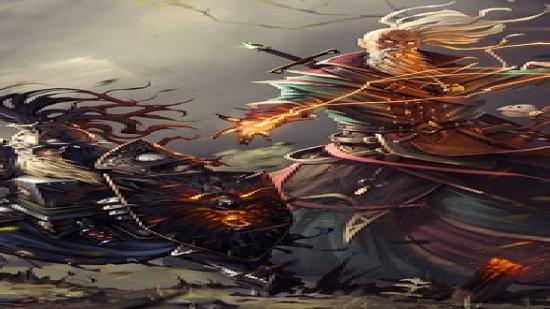Divinity: Original Sin 2 is, by all accounts, a very good game. It holds a steady 93% average score on Metacritic and has attracted critical superlatives up to and including PCGamesN’s own review, which credits its creators with having “shaped a genre moulded by nostalgia into genuinely new forms.”
It also appears, like many computer roleplaying games (or CRPGs if you have something against vowels), to be for experienced genre fans only. Screenshots show menus covered with text, a user interface cluttered with inscrutable command shortcuts, environments packed with bizarre fantasy creatures, and dialogue riddled with invented nouns. It looks like a whole lot to understand.
Is this the RPG for you? Find out by reading our Divinity: Original Sin 2 review.
I spent a few hours with the first Original Sin, a game I found as fascinating as it was impenetrable. Playing it, there was a constant sense that I was missing something important – that no matter how closely I paid attention, there were details of the world, aspects of the combat and character building systems, and worthwhile side-quests I was missing. Tired of smacking my head against its brick wall, and unenthused by the first act of its storyline, I abandoned it.
Despite this, the release of Original Sin 2 has reignited something in me – the praise it has garnered raised a brow. And so I started to play the sequel, determined to come to grips with what it offers, hoping that the same complexity and freedom that pushed me away from its predecessor would put me under its spell if I stuck with it.
The following is a diary of my time with its opening hours, and an honest-to-god, open-minded attempt to figure out what, exactly, makes the game tick.
The Character Creator
Original Sin 2 opens with a big, fancy character creator. It is filled with options for building the game’s protagonist out with skills that initially, being unfamiliar with its systems, mean absolutely nothing at all. Thank god, then, for the handful of pre-made characters whose set appearance and skillset cuts through the usual decision-making paralysis.
Deciding on the shiny red lizard man – clear MVP of the line-up – I watch the introductory cutscene. Seeing him in the opening area, set against the game world with a blood-coloured tail and long scaly neck poking out of a tattered shirt, I realise I can’t spend dozens of hours with what is essentially a walking, talking snake. Too repulsive, I decide. Who’s next?
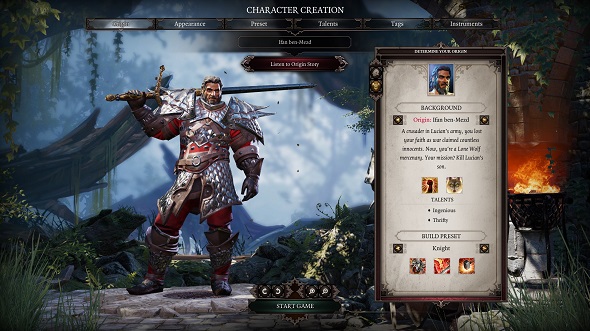
I rush back into the character creator again and, quickly overwhelmed, go with the boring, bearded human knight, Ifan ben-Mezd. I consider customising him a bit, but don’t want to get ahead of myself. His pre-set stat pages look fine. That’ll do, I decide, and let Jesus take the wheel.
Current mood: Thankful; regretful.
Hour One: The Story So Far
Now a boring old human, I set out to explore Original Sin 2’s opening level: a wooden prison ship carrying my character and other ‘Sourcerors’ to a place called Fort Joy. The plot is, as expected, thick with terms that don’t make any sense yet. What’s a ‘Godwoken?’ Some Tolkien-esque spin on the born again Christian? Who are ‘the Seven Gods?’ Can I just transpose Game of Thrones onto this and hope for the best?
Luckily, it isn’t long before I start chatting with other characters and the dialogue, though still dotted with inscrutable references, comes across with enough genuine personality that it doesn’t seem to matter. A stern-looking guard talks down to me, delighted to know I am heading to a place of utter torment. Another is more chipper – a true believer in the ruling, assumedly non-Catholic ‘Bishop’ who tells me the political decisions behind my imprisonment are all going to work out for the best.
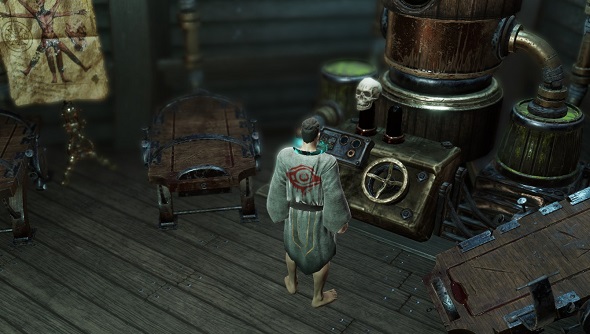
I then run into myself from a past life, the red lizard man, now a non-playable character called The Red Prince. He doesn’t look particularly aristocratic in his shackles and sackcloth, but still orders others around like a haughty jerk. Ugly andan asshole – perhaps I made the right decision after all. He and a few of the other characters speak in a way that is far more tangible than the so-far generic fantasy of the rest of the story. They have distinctly human personalities.
Take my future party member Fane who, despite being a talking skeleton, talks down to my shorter-lived human character with the tone of a disinterested adult answering a child’s endless questions about how the world works. Though they wear ornate robes and carry glowing wizard staffs, the guards are as gleefully condescending as power-drunk mall cops. They are all very entertaining.
For now, I am ignoring the reams of information and statistics that fill the menus. I have to if I want to get anything done.
Current mood: Intrigued; lizard regrets.
Hours Two and Three: Exploration
Shipwrecked following the tutorial area, wearing a set of sodden rags and a wooden bucket on my head, I am ready for whatever this game has to throw at me. Very quickly, I meet The Red Prince again and, thankfully, the arrogant jerk joins my party. The sting of not picking him dissolves as I realise I can now talk to and play as him.
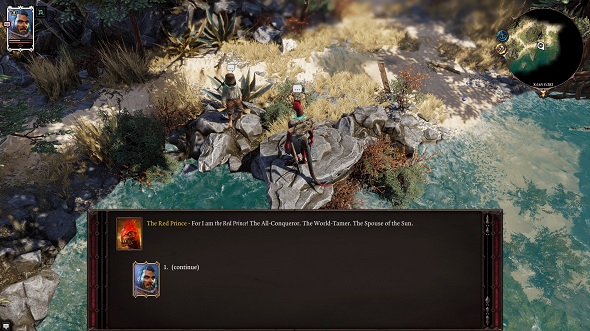
Heading into the nearby town of Fort Joy – which turns out to be an ironically named prison camp – a murderous elf joins the party, too. From there, a bustling area filled with people to chat with provides plenty of opportunities to encounter more of Original Sin 2’s dialogue. There’s an exiled elf leader, bandages covering her eyes, whose broken syntax crumples words spoken with the wounded dignity of a proud queen held captive in a foreign dungeon. There is a rough-talking black market dealer who communicates in clipped sentences and clears his throat every time he stops for breath. There’s Fane, the skeleton man again, who explains the practice of ‘ethical battlefield face-harvesting’ to me as if it is the stupidest thing not to understand.
With the in-game journal filling up with quests, comforted by the quality of the game’s writing, I am more invested in seeing this thing through. I don’t care about the main plot line very much yet (its fantasy theocracy and elf/dwarf/lizard-based allegorical racial politics are all fairly rote at this point), but the moment-to-moment process of picking through an area, chatting with various characters, and seeing how many opportunities are presented for open-ended problem solving is stroking the right part of my brain.
The combat so far, luckily, has been simple enough, too – so much so that I’m able to get by with a cursory understanding of what seems to be a complex battle and character development system. Sure, I can kill a few enormous beetles by whacking them with swords and slicing them with daggers. Not too many at once, of course, but two or three is no problem. I can do that just fine. For now, everything is okay.
Current mood: Intrigued; wary; at peace with not choosing to play as the lizard man.
Hours Three to Five: Let’s Fight
I pick a fight with a group of cheating gamblers and my sense of understanding Original Sin 2’s combat is beaten into mincemeat in tandem with the slack, bloodied bodies of my hopeless and hapless characters. Later, I stumble into a few prison guards and the process repeats. It goes without saying that a collection of fire slugs ruin me, too.
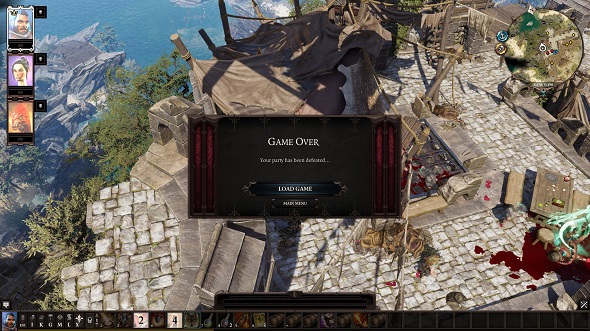
In each situation, I am able to quickly reload and sneak past or ignore these enemies entirely, but, at this stage, it is aggravating to know there is still one major part of the game I can’t seem to properly figure out. I don’t want to have to find alternative routes through the slug-filled cave when those slimy bastards attacked first. I would rather not hit the ‘sneak’ key (which, beautifully, turns the characters into supposedly unassuming shrubs or rocks) to edge past a group of guards happily chatting on a quick break from the torture they administer in a medieval-looking dungeon. I want to hold my own in a dust-up.
Getting a better grip on Original Sin 2’s combat system feels like the only hurdle left to overcome. The text-based role-playing is approachable, the exploration has me actually wanting to talk to every possible character, and I feel versed enough in how to build out my party now that I am unafraid to allocate skill points and start turning my boring human, angry elf, skeleton man, and lizard prince into the talkers and fighters I know they can be.
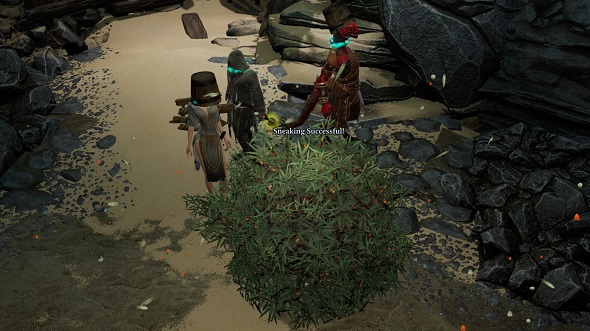
But still, no matter how cautiously I approach combat – no matter how carefully I choose skills, position my fighters, and examine the environment for oil to spill and fires to start – I am routinely outmatched. For now, still bothered by this, I am choosing to bypass fighting altogether, which, given that the game so far makes this a viable option, is a temporary solution. It just isn’t one I feel good about. My protagonist – human lump of vanilla ice cream that he is – deserves more. He’s a warrior, goddammit.
Current mood: determined.
Hours five to eight: the open world, opened
Soon after the last entry, I happen upon a wonderful character who not only accelerates the storyline (he serves as an important informant in an assassination subplot), but, incredibly, holds the figurative key that, for me, unlocks Original Sin 2’s combat. In short, he has a whole bunch of armour and weapons priced to match my place in the story. New swords and daggers, chest plates and boots, that allow my motley group to return to the last enemy that whooped them and enact revenge. I spend about half an hour buying and selling, unloading filthy stacks of torn linen starter gear and a not-insignificant part of my gold in exchange for shiny new gloves, a fire-spewing wand, and other items. Trading the wooden buckets my characters had been using as head protection for actual helmets doesn’t only allow them a bit of dignity, it lets them have a chance at surviving a scrap, too.
The fights since then haven’t been easily won and I’m getting a bit worried about how well my ad-hoc strategies (and the high price of ‘resurrection scrolls’) will last long-term. But I have a good understanding of both the intricacies of the combat system and, maybe more importantly, when to avoid opponents simply too tough for my character level and current equipment. The Red Prince survives long enough to barf flames on his enemies; Fane has a chance to summon magic rocks and hurl them at enemies – we can actually do some damage.
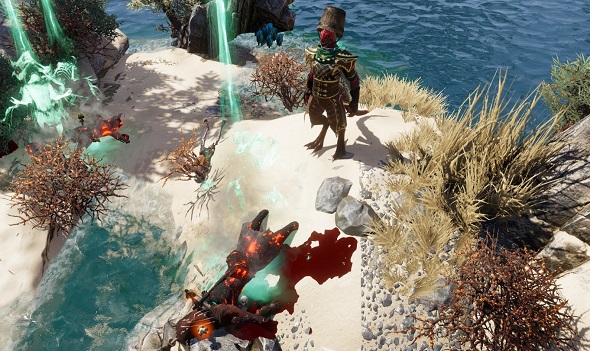
After many hours of grasping at the edges of its many elements, I feel like I understand the game – not fully of course, because it is too immense for that, but to the point that I am confident in being able to keep going. Not only that, but there is the sense that, having spent the time to learn how it all works, I want to continue onward and take advantage of this investment.
Luckily, Original Sin 2 doesn’t want to punish me for taking a while to get acclimated. It has forgiven (or outright disallowed) the kind of mistakes that would require me to restart from the beginning of the game after figuring out how to properly play what is a pretty niche genre. At almost every step, difficult and mandatory combat encounters notwithstanding, it has managed to provide inroads to a novice audience – whether through the simple inclusion of pre-built characters at its start, dialogue that backgrounds the more confusing aspects of its fantasy plot, or systems that encourage rather than punish bypassing fights.
These are all smart choices. They make the complexities of the genre easier to appreciate not by completely eliminating them, but by parceling their introduction out gradually. More than any other game of its type, Original Sin 2 seems keen to bring in new players alongside the old hands who already know what this style of play is all about. That is no small feat. This far in, seeing the potential of its design, it feels worth celebrating. And it is also a very large part of why, unlike its predecessor, I won’t be abandoning the adventure early.
Current mood: excited for what’s next.
